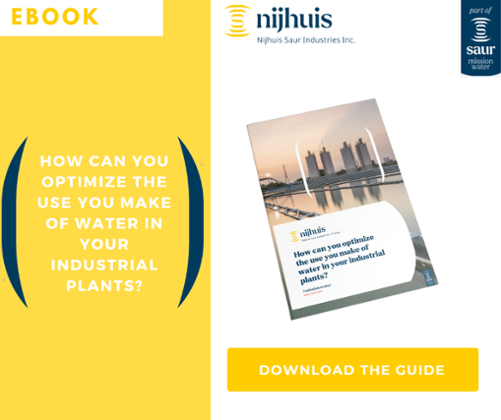From all perspectives, whether environmental, health, regulatory or financial, the introduction of a water cycle management system seems both essential and unavoidable in industry today. We can help guide you through this process, not only with a series of performance indicators, but also with the expertise of Nijhuis Saur Industries France.
- Industrial water management... a key business strategy
- From performance indicators to best practices
1 - Industrial water management... a key business strategy
Experts are forecasting that the availability and quality of water may become a limiting factor for economic development in future decades. In industry, managing and controlling the water cycle are already key elements of corporate strategy. More and more tools and systems are now available to plant managers for monitoring production quantity and quality. Unsurprisingly, they can also monitor the number of cubic meters consumed per ton produced, or the total volume of water consumed in one day, one month or one year.
In France, there is also a more precise level of monitoring, which is carried out in accordance with criteria set by the Regional Health Agencies (ARS) when the water concerned is classified as drinking water. These criteria are industry-specific, and in some cases even plant-specific. So in the food, cosmetics and pharmaceutical industries, monitoring tends to focus particularly on traces of pesticides and the bacteriological index. Industrial plants producing baby formula must ensure that the water they use is free of chlorates, which have undesirable effects on health and are now banned in this industry.
Many other indicators may also be relevant to particular industries, including pH, turbidity, temperature, conductivity or the presence of metals. Some relate more specifically to water that is ultimately discharged, and include cyanide and Polycyclic Aromatic Hydrocarbons (PAHs). Or indeed the water production stage itself, including the loss index, which provides an indication of the percentage of water lost between pumping from the borehole and distribution, the cost per cubic meter distributed, which will increase if the borehole ceases to perform as it should, or the number of maintenance interventions compared with emergency repairs.
2 - From performance indicators to best practices
Once the relevant Key Performance Indicators (KPIs) for the plant have been identified, it becomes possible for industrial users to set precise targets, and for water suppliers to enter into contractual commitments around improving the management of the industrial water cycle.
One of the best ways of achieving water management targets is to begin by reviewing how information is gathered and fed back by monitoring the amounts of water used for each type of consumption, and monitoring sensor reliability as part of a regular maintenance plan. The information gathered must then be shared with all stakeholders. In most cases, this stage alone can deliver substantial water savings of up to 20%!
The monitoring results provide the basic information required to implement actions and initiatives specific to different locations within the industrial plant. Generally speaking, computer-assisted maintenance is a realistic option for optimizing preventive and remedial maintenance. There are also other ways of optimizing the cost of water and/or water consumption. For example, at water production plant level, where the accumulated experience of the plant manager can then be applied to reduce the volume of water treatment reagents consumed, without compromising the rate and quality of production. Adding a variable speed drive to a pump can also help to limit overall energy consumption. In production plants, more traditional solutions include fitting foamers and/or cleaning guns to hoses to limit water consumption during production line washdowns.
Other good practices remain specific to particular sectors of industry. So, for example, plants producing baby formula might be better advised to use chlorine gas - which does not produce chlorates - for disinfection, rather than bleach. But regardless of industry, the experts at Nijjhuis Saur Industrie France are able to offer targeted support. Our aim is to act not only as a supplier of water, but as a genuine business partner with the ability to guide industrial users in their operational management of the water cycle.
These articles may also be of interest:
Would you appreciate help and support in managing the water cycle of your industrial plant? Click here to contact us. One of our experts will then get back to you.
